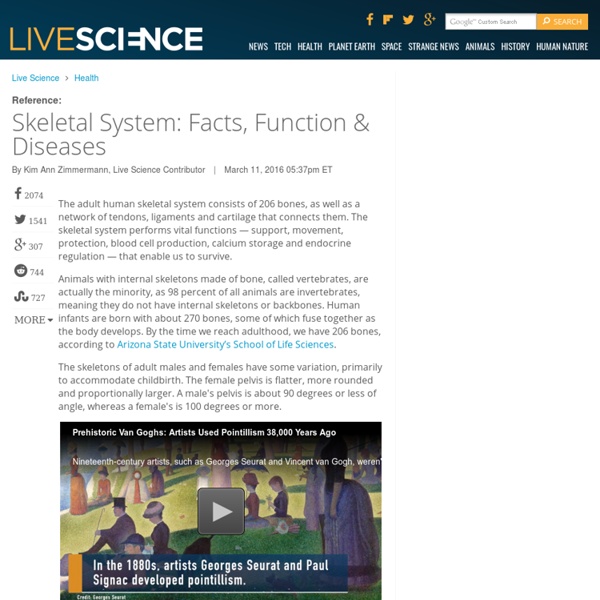Skeletal System Basics (square)
Human skeleton - Wikipedia
Internal framework of the human body The human skeleton is the internal framework of the human body. It is composed of around 270 bones at birth – this total decreases to around 206 bones by adulthood after some bones get fused together.[1] The bone mass in the skeleton makes up about 14% of the total body weight (ca. 10–11 kg for an average person) and reaches maximum density around age 21.[citation needed] The human skeleton can be divided into the axial skeleton and the appendicular skeleton. The human skeleton performs six major functions: support, movement, protection, production of blood cells, storage of minerals, and endocrine regulation. Divisions Axial The axial skeleton (80 bones) is formed by the vertebral column (32–34 bones; the number of the vertebrae differs from human to human as the lower 2 parts, sacral and coccygeal bone may vary in length), a part of the rib cage (12 pairs of ribs and the sternum), and the skull (22 bones and 7 associated bones). Appendicular Functions
Would You Break Your Legs to Be Taller? (StuffYouShouldKnow.com, April 2013)
Leave it to America to take a medical procedure created to improve the lives of children born with growth disorders and use it for cosmetic surgery. China's guilty of exploiting the procedure, appropriately called leg lengthening surgery, too. As the name suggests, the surgery is used to lengthen the legs (or leg, depending on the case) of the patient and it does it in a pretty simple, if not barbarically old-timey, technique: by breaking the legs and prying them apart. The surgeon carrying out the leg lengthening breaks the legs of the patient and inserts a set of metal discs into the newly-opened gap. The discs are attached to a telescoping rod outside the leg that is used to pry the bones slowly apart. Over the course of the months following the surgery, the patient must visit the doctor to have the rod adjust and the legs pried apart, in increments of millimeters, until the legs have reached the desired length. I am not a short man, but I have my flaws.
Skeletal System – Labeled Diagrams of the Human Skeleton
[Continued from above] . . . calcium, iron, and energy in the form of fat. Finally, the skeleton grows throughout childhood and provides a framework for the rest of the body to grow along with it. The skeletal system in an adult body is made up of 206 individual bones. SkullHyoidAuditory ossiclesRibsSternumVertebral column The appendicular skeleton is made up of 126 bones in the folowing regions: Upper limbsLower limbsPelvic girdlePectoral (shoulder) girdle SkullThe skull is composed of 22 bones that are fused together except for the mandible. The bones of the superior portion of the skull are known as the cranium and protect the brain from damage. Hyoid and Auditory OssiclesThe hyoid is a small, U-shaped bone found just inferior to the mandible. The malleus, incus, and stapes—known collectively as the auditory ossicles—are the smallest bones in the body. VertebraeTwenty-six vertebrae form the vertebral column of the human body. The humerus is the bone of the upper arm. Long.
Weird Medical Conditions: Disappearing Bone Disease (StuffYouShouldKnow.com, Sept 2013)
Thanks to a Stuff You Should Know listener named Dr. Bob, we can say we've heard of a condition called disappearing bone disease which, amazingly, is exactly what it sounds like. The clinical term for the condition, which is surprisingly not hereditary, is massive osteolysis. But perhaps most frequently, it's called Gorham's disease, after Dr. Lemuel Gorham, one of the condition's pioneering investigators who co-authored the first comprehensive survey and study on it in the 1950s. If you've heard our episode on broken bones, you already know that the human skeleton is in a constant process of breaking down and absorbing old bone cells and replacing them with new ones. Since it's not passed down through families, it tends to take the sufferer by surprise. Still today, medical science isn't sure what causes Gorham's. What's perhaps most mysterious is that a number of cases of Gorham's have ended in spontaneous remission, where it just kind of goes away. Bonus: Maybe this lady has it



